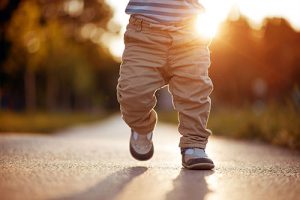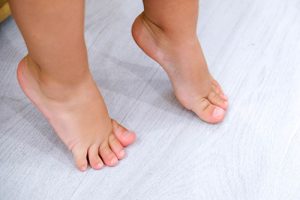Like most parts of a newborn’s body, your infant’s feet are undeveloped at her time of birth. As she grows and learns to walk, the soft, pliable tissue that structures her feet will solidify into bony tissue in a process known as ossification. Her feet will continue to grow and develop well into her late teens.
You can help your child’s feet to develop as naturally as possible by choosing the right footwear and providing her with plenty of opportunity to exercise. Children’s feet grow in spurts so is important to keep an eye on their changing size. Until your child is 2 years old, we recommend checking their foot length every two months and then every three months until they are 3 years old.
Child foot development: 3-6 Months
Your baby’s foot is structured by tissue similar to cartilage that will eventually ossify into bone. Gaps between the tissues allow the foot to easily – and painlessly – bend out of shape.
Shoes to choose – Avoid overly tight or rigid shoes that force your child’s feet into unnatural positions. Shoes should have flexible soles with smooth interiors that won’t rub or irritate the skin.
6-9 Months
As your baby puts weight on her feet, the cartilage-like tissue will harden to become fully-formed bone tissue. This is why early foot development is so important to your child’s future wellbeing. Ill-formed feet can increase the likelihood of stress and overuse injuries, like plantar fasciitis and bunions.
Shoes to choose – Shoes should fit comfortably and leave 1cm of room in the toes for growth. Since your child will be learning to walk in this stage, make sure her shoes have grippy, textured soles and protective material surrounding the toes and heels.
9-18 months

Shoes to choose – During this stage, it seems like your toddler is outgrowing her shoes every day! She’ll go up about two whole sizes each year.
Buying second-hand is a good choice for the budget-conscious, as long as the shoes aren’t too worn in. Examine the soles for signs of wear and call your foot and ankle specialist if you have questions. Just make sure the shoes are well-cushioned for active playtime.
2-4 years
As the navicular bone ossifies and “baby fat” in the feet melts away, your child’s feet will start to look more mature. Your child’s feet now have 45 separate bones – many of which will fuse together into her teen years.
Shoes to choose – Most children still have flat feet at this stage, so you shouldn’t need to worry about arch supports. Soles should be flexible in the front and sturdy in the back.
4+ years
Your child’s feet will enter a slower state of growth – about one whole size each year – as her bones start to fuse and her arch develops.
Shoes to choose – The key word here is durability. Your child’s shoes will need to stand up to hours of pounding and playing every day.
How can I help my child’s feet develop naturally?
Here are a few tips that will let them grow, develop and strengthen as naturally as possible:
- Encourage flexibility by tickling her feet and playing with her toes.
- As she begins to stand and walk, allow her to strengthen the muscles and tendons in her feet by letting her walk around barefoot. This is best done indoors for safety reasons.
- When tucking your child in for bed, make sure her legs have room to kick and move freely.
- Select cotton or cotton- wool blend socks and stockings to absorb moisture and keep the feet warm.
- Your baby’s feet will size up quickly. Keep checking her socks to make sure they aren’t restricting circulation.
- Booties and shoes should leave a little room for growth in the toes.
What pediatric foot problems should I look for?
Your child may not notice or be able to tell you when something is wrong with her feet. Check them daily, especially after playing outside. Common foot conditions in children include:
- Ingrown Toenails. An ingrown toenail occurs when the nail grows into the nearby flesh, causing redness, swelling, and pain. You can generally prevent ingrown toenails by cutting the nail with clippers straight across, instead of curved. Never cut down the side of the nail. Use a file to soften sharp edges.
- Blisters. Your child can get blisters when breaking in new shoes, or when her shoes fit a little too loosely and rub against her skin. If she has a blister, take her shoes and socks off and let the blister resolve itself. Do not pick or pop the blister. If the skin breaks on its own, use a topical antibiotic ointment and clean bandage to avoid an infection.
- Warts. Warts are caused by a virus and are very common in children. They can appear in singles or clusters, and can easily spread to other parts of the body through touch. They usually clear up on their own within a year or two, but you can speed up the process with over-the-counter medication.
- Plantar Warts. A plantar wart (aka verruca) is a flat wart found on the sole of the foot. Plantar warts are usually white with a black spot in the center, and they can be painful to walk on. Your child’s foot and ankle specialist can treat this type of wart.
- Athlete’s Foot. Athlete’s foot is an itchy rash between the toes caused by a fungal infection. Athlete’s foot is more common in children who visit public swimming pools and use public showers. It’s okay to use these facilities, but make sure to dry between your child’s toes afterwards and dress her in clean cotton socks.
- Hand, Foot, and Mouth Disease. This viral infection is common in children under age 10 that causes a spotty rash and/or blisters on the hands, feet, and mouth. The disease can also affect the diaper area, and can cause fever, stomach ache, and sore throat. Symptoms usually clear up after a week.
What do I need to know about developmental foot conditions?
While developmental conditions are much less common than the minor ailments above, they may need medical treatment. If you suspect a developmental problem with your child, please talk to your pediatrician or foot and ankle specialist. Developmental foot and ankle conditions include:
Flat Feet. Flat feet are to be expected from age 0-5. Arches will develop as your child gains posture and loses baby fat.
- Out-toeing and In-toeing. The tendency to walk with toes pointed outward or inward (also known as pigeon-toeing) is also quite common in toddlers. Typically, out-toeing and in-toeing will correct themselves around age 8 or 9. If not, visit your child’s foot and ankle specialist.
- Tip-toeing. Some toddlers will do most of their cruising and walking on their tippy-toes. This isn’t a problem before age 3. After that, however, you may want to make an appointment with a foot and ankle specialist. Some conditions, including a shortened Achilles tendon and cerebral palsy, can cause toe-walking.
- Club Foot. Club foot is a congenital disorder in which a baby is born with one or both of her feet twisted awkwardly inwards and downwards. About 1 out of every 1,000 children is born with club foot. Visit a foot specialist right away to begin treatment. Most cases can be treated without surgery.
If you’re concerned about the development of your child’s feet, we’re here to help. Our nationally recognized foot and ankle specialists offer the most advanced podiatric care and the highest success rates in the nation. We are leaders in the research and treatment of all foot and ankle conditions.
For more information or to schedule a consultation, please call (877) 736-6001 or visit us at www.footankleinstitute.com.
- Swollen Feet During Pregnancy - September 12, 2024
- What Are Shin Splints? - August 29, 2024
- How Many Steps Do I Need A Day? - August 14, 2024

